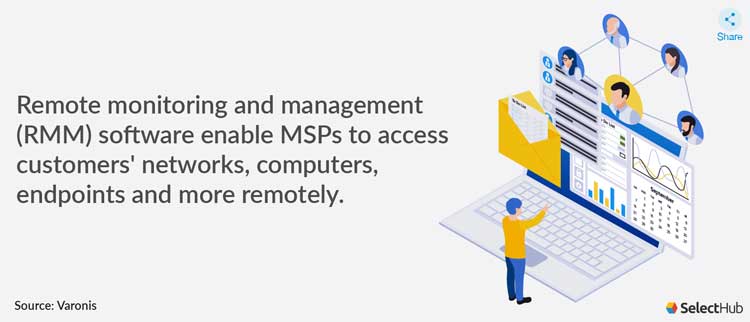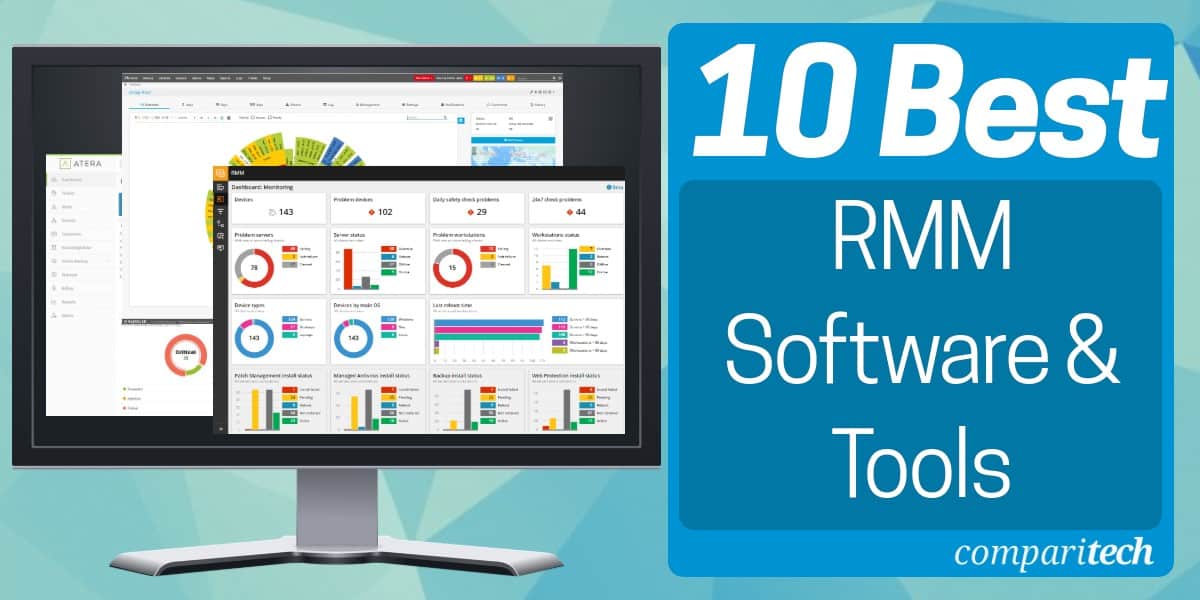Automating routine tasks and workflows using RMM software is a game-changer for IT teams. Imagine a world where patching, software updates, and endpoint monitoring happen seamlessly, without constant manual intervention. This isn’t science fiction; it’s the reality RMM software offers, streamlining operations and freeing up valuable IT staff time. We’ll explore how to leverage RMM’s automation capabilities to boost efficiency, enhance security, and ultimately, deliver a better user experience.
From defining routine tasks and understanding the various workflows that benefit from automation, to implementing a step-by-step guide and addressing crucial security considerations, this deep dive into RMM automation will equip you with the knowledge to transform your IT management. We’ll examine different RMM platforms, explore advanced techniques like scripting and machine learning, and showcase real-world success stories that highlight the transformative power of RMM automation.
Get ready to optimize your IT operations like never before!
Defining Routine Tasks and Workflows in RMM: Automating Routine Tasks And Workflows Using Rmm Software

Automating routine tasks and workflows is a game-changer for IT teams. Remote Monitoring and Management (RMM) software offers powerful tools to streamline operations, freeing up valuable time for more strategic initiatives. Understanding how to define and automate these tasks within an RMM system is key to maximizing its benefits. This involves identifying repetitive processes, selecting the right automation methods, and carefully considering the potential improvements in efficiency and security.
Efficiently managing IT infrastructure requires a clear understanding of routine tasks and how to automate them. RMM software excels at this, allowing you to proactively address issues and improve overall system performance.
Common Routine Tasks Automated by RMM Software
The ability to automate routine tasks is a cornerstone of effective RMM utilization. By automating these tasks, IT teams can significantly reduce manual effort and human error, leading to improved efficiency and reduced operational costs. The following table highlights some common examples:
| Task | Description | Automation Method | Benefits |
|---|---|---|---|
| Patch Management | Automatic deployment of software updates and security patches to endpoints. | Scheduled scripts, automated patch deployment tools within the RMM platform. | Reduced vulnerability to security threats, improved system stability, minimized downtime. |
| Software Inventory | Automatic discovery and tracking of software installed on managed devices. | Automated scans and reporting features within the RMM platform. | Improved asset management, simplified software license compliance, better understanding of software usage. |
| Backup and Recovery | Automated creation and management of backups for critical data. | Scheduled backups, automated recovery procedures, cloud-based storage integration. | Reduced data loss risk, faster recovery times in case of failures, improved business continuity. |
| Remote Monitoring | Continuous monitoring of system performance and resource utilization. | Real-time alerts, automated performance monitoring tools, proactive issue detection. | Faster identification and resolution of issues, proactive maintenance, improved system uptime. |
Workflows Benefitting from RMM Automation
Automating workflows using RMM software translates to a significant boost in productivity and efficiency. Various workflows benefit greatly from this approach, improving the overall quality and speed of IT operations.
Implementing automated workflows within an RMM system significantly enhances the efficiency of IT operations. The following points illustrate various types of workflows that are ideal candidates for automation:
- Onboarding New Devices: Automating the initial configuration, software deployment, and security setup for new devices reduces manual effort and ensures consistency.
- Incident Response: Automating the process of identifying, diagnosing, and resolving IT incidents improves response times and reduces resolution time.
- Security Auditing: Automated security scans and vulnerability assessments improve security posture and reduce the risk of breaches.
- Help Desk Ticket Management: Automating the assignment, tracking, and resolution of help desk tickets streamlines the support process and improves customer satisfaction.
- Offboarding Devices: Automating the process of securely removing devices from the network, wiping data, and decommissioning hardware saves time and reduces security risks.
Challenges of Managing Routine Tasks and Workflows Without RMM Automation
Managing routine tasks and workflows without RMM automation presents significant challenges. The lack of automation leads to inefficiencies, increased operational costs, and potential security risks.
The absence of automated systems for routine IT tasks significantly impacts operational efficiency and security. Here’s a breakdown of the key challenges faced:
Without automation, manual processes become time-consuming and error-prone. This leads to increased operational costs, delays in service delivery, and potential security vulnerabilities due to inconsistencies in the application of security policies. Furthermore, the lack of centralized monitoring and management makes it difficult to proactively identify and address potential problems, resulting in increased downtime and lost productivity.
RMM Software Features for Automation

Automating routine tasks and workflows is no longer a luxury for IT departments; it’s a necessity. RMM (Remote Monitoring and Management) software plays a pivotal role in this shift, offering powerful tools to streamline operations and boost efficiency. Choosing the right RMM platform, however, requires careful consideration of its automation capabilities. Let’s delve into the features that make this possible.
The automation capabilities of different RMM platforms vary significantly, impacting their overall effectiveness in managing IT infrastructure. While some offer basic scripting and scheduled tasks, others provide sophisticated workflows and integrations, dramatically improving efficiency. This section will compare and contrast three popular RMM solutions, highlighting their strengths and weaknesses in automation.
Comparison of Automation Capabilities Across Three RMM Platforms
Let’s consider three hypothetical RMM platforms – “AutoPilot,” “TaskMaster,” and “FlowControl” – to illustrate the diversity in automation features. AutoPilot offers basic scheduled tasks and simple scripting capabilities, suitable for smaller organizations with less complex needs. TaskMaster provides more advanced features, including visual workflow builders and support for more complex scripting languages, making it ideal for mid-sized businesses.
FlowControl, on the other hand, boasts a robust API and extensive integrations, enabling highly customized automation solutions for larger enterprises with intricate IT environments. AutoPilot might excel at simple patch management automation, while TaskMaster could handle more sophisticated processes like automated user provisioning and de-provisioning. FlowControl could manage these processes, plus integrate with a ticketing system to automatically generate tickets upon system failures, all orchestrated through a visual workflow.
Key Features Enabling Automation of Routine Tasks
Several key features within RMM software are crucial for effective automation. These features allow IT administrators to proactively manage their infrastructure, reducing manual intervention and improving overall system stability and security.
- Scheduled Tasks: The ability to schedule routine tasks like software updates, backups, and security scans at pre-defined intervals, ensuring consistent maintenance without manual intervention.
- Scripting Capabilities: Support for scripting languages (e.g., PowerShell, Python) allows for the creation of custom automation scripts to address specific needs and integrate with other systems.
- Workflow Automation: The ability to create complex workflows that orchestrate multiple tasks, enabling sophisticated automated processes like incident response or user onboarding.
- Policy-Based Automation: Defining policies that trigger automated actions based on predefined conditions (e.g., automatically disabling a user account after multiple failed login attempts).
- Remote Control and Management: The ability to remotely control and manage endpoints allows for quick troubleshooting and remediation of issues, often automating the process through pre-defined scripts.
Integration Capabilities with Other IT Management Tools, Automating routine tasks and workflows using rmm software
The ability to integrate with other IT management tools significantly expands the automation potential of RMM software. Seamless data exchange and coordinated actions across different platforms enhance efficiency and provide a holistic view of the IT infrastructure.
For instance, integrating an RMM platform with a ticketing system can automate the creation of tickets upon detecting system failures or security alerts. Integration with a PSA (Professional Services Automation) tool can streamline invoicing and reporting. Similarly, integrating with a monitoring tool can allow for automated responses to performance alerts, proactively addressing potential issues before they impact users. This interconnectedness transforms isolated tools into a cohesive, automated system.
Automating routine tasks and workflows using RMM software is a game-changer for IT teams, freeing up valuable time for more strategic initiatives. However, successfully managing remote teams presents its own set of hurdles; discover key insights and solutions in our comprehensive guide on challenges and solutions in managing remote teams with rmm. By addressing these challenges, you can optimize your RMM strategy for even greater efficiency in automating tasks and improving overall team productivity.
Automating routine tasks and workflows using RMM software boosts efficiency, freeing up IT teams for more strategic initiatives. This streamlining extends beyond IT; consider how HR benefits from automation, especially in onboarding and offboarding, as detailed in this insightful article on the role of HRIS system in improving employee onboarding and offboarding processes. Ultimately, efficient automation across all departments, from IT to HR, leads to a more productive and streamlined organization.